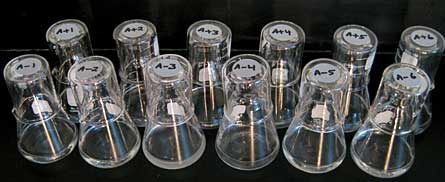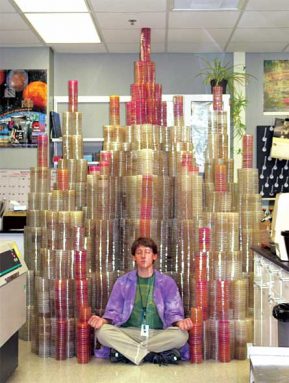Hitting the redo button on evolution
Scientists are experimenting with bacteria to see if evolution plays out the same way every time
People have always wondered why plants and animals are built the way they are. Charles Darwin, an Englishman who lived in the 1800s, was very curious about the shape of life forms, and did lots of experiments to find some answers. He came up with the theory of evolution, which helps explain how life on Earth came to be in its many forms.
A big part of Darwin’s evolution theory is a process called natural selection — you might have heard it called “survival of the fittest.” Natural selection says that plants, animals and other life forms that are best suited to their environment survive and have offspring. If the environment changes, organisms whose forms can change, or adapt, best over time to the new conditions have a better chance of surviving.
For instance, fish called sticklebacks have spines that keep bigger fish from gulping them down. Sticklebacks usually live in the ocean, where escaping from big fish is a problem, and spineless fish would quickly be gobbled up. But some kinds of sticklebacks live in ponds where there are no other fish to worry about. Instead there are huge insects, such as dragonflies, that can grab sticklebacks by their spines and eat them like you hold a Popsicle by the stick and slurp it up. In that case, having spines is bad. Some sticklebacks that live in these ponds have lost their spines over time. Now the dragonflies have nothing to hold on to, making this spineless fish “fitter” and able to produce more offspring than fish with spines who would get eaten by the dragonflies.
Scientists have wondered for a long time whether evolution would work the same way every time. Some think if you borrowed Hermione Granger’s time-turner and went back in time to do a redo of evolution, things would turn out basically the same as they are now. Some details might be different, but in general, evolution would probably make plants and animals that are very similar to the ones alive today.
But other scientists don’t agree. They think that if you hit the redo button, a small change somewhere along the line could produce very big changes later. It would be like recording a baseball game and then when you watched it again having one play change that lead to the other team winning.
Richard Lenski at Michigan State University in East Lansing is doing experiments with bacteria to find out who is right. In 1988, Lenski lined up 12 flasks at the start of his experiment. In each flask he placed identical bacteria, known as E. coli, and fed all of the bacteria the same food. The bacteria’s food is a liquid that contains vitamins, nutrients and a kind of sugar called glucose.
Bacteria that are better at using glucose grow faster. They also make many more copies of themselves (how bacteria reproduce) than bacteria that don’t digest glucose as well. Each day, Lenski randomly takes some of the bacteria and puts them in a new flask containing the same liquid. The remaining bacteria are frozen, which is like hitting the pause button. Scientists can go back later and start the experiment again with the paused, frozen bacteria. By now, the bacteria have made more than 45,000 generations, or groups of organisms born around the same time.
 |
|
These 12 flasks contain separate populations of E. coli bacteria, all evolved from a single ancestor. Only the bacteria in flask A-3 (third from left in the back row) evolved the ability to eat citrate.
|
| Neerja Hajela and Brian Baer/Michigan State University |
By using a dozen different flasks, Lenski was basically setting up 12 different recordings of the same game, pushing “play” at the same time and watching to see if all the games would end the same. For many generations, all of the bacteria in all of the flasks seemed to be playing their games the same. All of the bacteria grew bigger than their ancestors and got better at eating glucose.
But then something different happened. The liquid food in the flasks also contains a type of sugar called citrate. E. coli don’t eat citrate. At least most E. coli don’t. But after about 30,000 generations, bacteria in one of the flasks suddenly started to chow down on citrate.
“They’ve been eating the main course for thousands of generations,” Lenski says. “They didn’t realize that there was a dessert tray around the corner.”
 |
|
Zachary Blount sits in front of a tower of petri dishes. He used these dishes to test trillions of bacteria to see which evolved the ability to eat a chemical called citrate.
|
| Brian Baer/Michigan State University |
Zachary Blount, a graduate student in Lenski’s lab, replayed the citrate game more than 40 trillion times using the frozen bacteria. He found that the evolution game isn’t played the same every time. Fewer than one in one trillion bacteria make the plays that allow them to end up finding the dessert cart.
For now, the citrate-eating bacteria still eat their glucose dinner along with dessert. But maybe with time some of those E. coli will start eating only dessert, says Blount.
“It would be amazing,” Blount says. “It would be like teenagers who no longer like to eat pizza — they prefer broccoli.”
So who is right — the scientists who think evolution ends the same way each time? Or the ones who think that surprise endings are more likely? Both, says Lenski. In 11 flasks the game seems to be playing out the same, meaning that the first group of scientists is mostly right. But the rare appearance of the citrate eaters means that the group who believes in surprise endings is also correct, he says.
Going Deeper:







